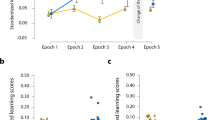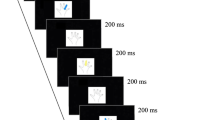Conclusions
Differences in performance of a procedural task, attributable to motion, are identified with the putting together of a new motor response. No reliable difference was shown between motion and still sequences in the overall procedural sequence of steps. The use of animation arrows to direct attention and to show the direction of motion did not help learning. Motion does not appear to function as a cue focusing attention upon the direction of movement or critical elements of the display. The results of the present studies support the recommendations of Allen and Weintraub (1968). They suggest that the use of motion in a display is definitely indicated when the particular content to be learned consists of the movement itself and its characteristics, or where the content is enhanced and differentiated by the cues provided in the action of the movement. Until the bases for differential individual needs for motion can be determined, displays that provide motion are best used wherever procedural tasks requiring motions new to the student are taught.
Similar content being viewed by others
References
Allen, W. H. Media stimulus and types of learning.Audiovisual Instruction, 1967,12, 27–31.
Allen, W. H., & Weintraub, R.The motion variable in film presentation. OE Final Report (Project No. S-1123). Los Angeles: University of Southern California, Research Division, Department of Cinema, 1968.
Bandura, A.Principles of behavior modification. New York: Holt, Rinehart, & Winston, 1969.
Duval, D. P., Greenhill, L. P., Hutchison, G., & Murnin, J. A.The effectiveness, acceptability and feasibility of technical training courses recorded on sound motion picture and slides plus tape. Technical Report NAVTRADEVCEN 364-1. Port Washington, N.Y.: U.S. Naval Training Device Center, 1960.
Dwyer, F. M. The instructional effect of motion in varied visual illustrations.Journal of Psychology, 1969,73, 167–172.
Fleming, M. L.Perceptual principles for the design of instructional materials. OE Final Report (Project No. 9-E-001). Blcomington, Ind.: Indiana University, Audio-Visual Center, 1970.
Greenwald, A. G., & Albert, S. M. Observational learning: A technique for elucidating S-R mediation processes.Journal of Experimental Psychology, 1968,76, 267–272.
Gropper, G. L. Programing visual presentations for procedural learning.A VCommunication Review, 1968, 16(1), 33–56.
Laner, S. The impact of visual aid displays showing a manipulative task.Quarterly Review of Experimental Psychology, 1954, 6(Part 3), 95–106.
Laner, S. Some factors influencing the effectiveness of a training film.British Journal of Psychology, 1955,46, 280–294.
Lumsdaine, A.A. (Ed.).Student response in programmed instruction. Washington, D.C.: National Academy of Science, National Research Council, 1961.
Lumsdaine, A. A., & May, M. A. Mass communication and educational media.Annual Review of Psychology 1965, 1965,16, 475–534.
Lumsdaine, A. A., Sulzer, R. L., & Kopstein, F. F. The effect of animation cues and repetition of examples on learning from an instructional film. In A. A. Lumsdaine (Ed.),Student response in programmed instruction. Washington, D.C.: National Academy of Science, National Research Council, 1961. Pp. 241–270.
May, M. A. The psychology of learning from demonstration films.Journal of Educational Psychology, 1946,37, 1–12.
May, M. A. Patterns of words and pictures. In M. A. May & A. A. Lumsdaine (Eds.),Learning from films. New Haven, Conn.: Yale University Press, 1958. Pp. 150–167.
May, M. A. Word-picture relationships in audio visual presentations: The acquisition of skills, concepts and understandings. In R. A. Weisgerber (Ed.),Instructional process and media innovation. Chicago: Rand McNally, 1968. Pp. 18–39.
Roshal, S. M.Effects of learner representation in film-mediated perceptual-motor learning. Technical Report SDC 269-7-5. Port Washington, N.Y.: Special Devices Center, 1949.
Rubin, G., Von Treba, P., & Smith, K. V. Dimensional analysis of motion: III. Complexity of movement pattern.Journal of Applied Psychology, 1952,36, 272–276.
Sheffield, F. D. Theoretical considerations in the learning of complex sequential tasks from demonstration and practice. In A.A Lumsdaine (Ed.),Student response in programmed instruction. Washington, D.C.: National Academy of Science, National Research Council, 1961. Pp. 13–32.
Silverman, R. E.The comparative effectiveness of animated and static transparencies. Report NTDC TR 78-1. Port Washington, N.Y.: U.S. Naval Training Device Center, 1958.
Author information
Authors and Affiliations
Additional information
The research reported in this paper was performed at HumRRO Division No. 2, Fort Knox, Kentucky, under Department of the Army Contract with HumRRO. The contents of this paper do not necessarily reflect official opinions or policies of the Department of the Army.
Rights and permissions
About this article
Cite this article
Spangenberg, R.W. The motion variable in procedural learning. AVCR 21, 419–436 (1973). https://doi.org/10.1007/BF02769866
Issue Date:
DOI: https://doi.org/10.1007/BF02769866




